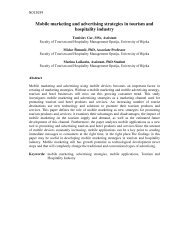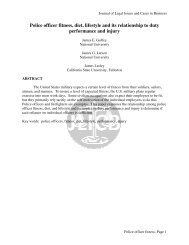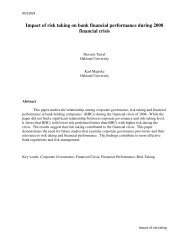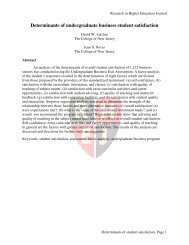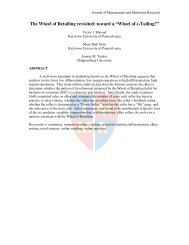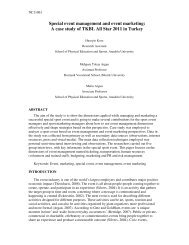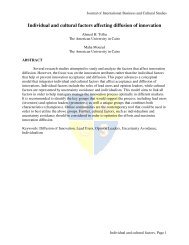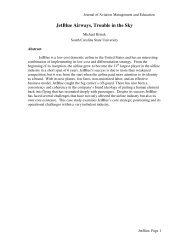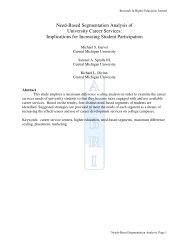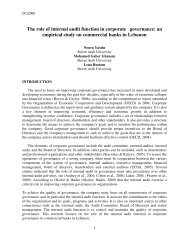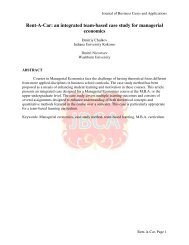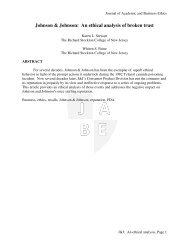An analysis of cultural impact on international business performance ...
An analysis of cultural impact on international business performance ...
An analysis of cultural impact on international business performance ...
You also want an ePaper? Increase the reach of your titles
YUMPU automatically turns print PDFs into web optimized ePapers that Google loves.
ABSTRACT<br />
Journal <str<strong>on</strong>g>of</str<strong>on</strong>g> Management and Marketing Research<br />
<str<strong>on</strong>g>An</str<strong>on</strong>g> <str<strong>on</strong>g>analysis</str<strong>on</strong>g> <str<strong>on</strong>g>of</str<strong>on</strong>g> <str<strong>on</strong>g>cultural</str<strong>on</strong>g> <str<strong>on</strong>g>impact</str<strong>on</strong>g> <strong>on</strong> internati<strong>on</strong>al <strong>business</strong><br />
<strong>performance</strong> via foreign market entry<br />
mode: case <str<strong>on</strong>g>of</str<strong>on</strong>g> South Korean MNCs<br />
Che<strong>on</strong>g-A Lee<br />
Pusan Nati<strong>on</strong>al University<br />
Ho-Yeol Bang<br />
Pusan Nati<strong>on</strong>al University<br />
J<strong>on</strong>g Wook Ha<br />
Columbus State University<br />
Joo Young Lee<br />
The University <str<strong>on</strong>g>of</str<strong>on</strong>g> West Alabama<br />
Young Hee Yun Kim<br />
Tuskegee University<br />
Research <strong>on</strong> the entry mode <str<strong>on</strong>g>of</str<strong>on</strong>g> multinati<strong>on</strong>al companies (MNCs) to a new market has<br />
been <strong>on</strong>e <str<strong>on</strong>g>of</str<strong>on</strong>g> the major topics in the internati<strong>on</strong>al <strong>business</strong>, and the <str<strong>on</strong>g>cultural</str<strong>on</strong>g> factor has been<br />
regarded as <strong>on</strong>e <str<strong>on</strong>g>of</str<strong>on</strong>g> the major factors to explain the entry mode selecti<strong>on</strong> <str<strong>on</strong>g>of</str<strong>on</strong>g> MNCs. Based <strong>on</strong> the<br />
development <strong>on</strong> the <str<strong>on</strong>g>cultural</str<strong>on</strong>g> factors <strong>on</strong> entry mode, MNCs can enter a market with joint venture<br />
or a wholly owned subsidiary. This study tries to extend the <str<strong>on</strong>g>analysis</str<strong>on</strong>g> <strong>on</strong> the <str<strong>on</strong>g>cultural</str<strong>on</strong>g> factor by<br />
investigating whether a MNC prefer a new establishment <str<strong>on</strong>g>of</str<strong>on</strong>g> <strong>business</strong> or an acquisiti<strong>on</strong> <str<strong>on</strong>g>of</str<strong>on</strong>g> an<br />
existing local firm when the MNC enters the market with a wholly owned subsidiary. Also this<br />
study tests whether a MNE with more global experience has been less affected by <str<strong>on</strong>g>cultural</str<strong>on</strong>g><br />
difference from a target market.<br />
The results from the empirical <str<strong>on</strong>g>analysis</str<strong>on</strong>g> <strong>on</strong> the first hypothesis show that a MNC prefers a<br />
new establishment <str<strong>on</strong>g>of</str<strong>on</strong>g> <strong>business</strong> when it enters a market as a wholly owned subsidiary. The sec<strong>on</strong>d<br />
hypothesis is rejected with the empirical tests, and <str<strong>on</strong>g>impact</str<strong>on</strong>g> <str<strong>on</strong>g>of</str<strong>on</strong>g> <str<strong>on</strong>g>cultural</str<strong>on</strong>g> difference <strong>on</strong> <strong>performance</strong><br />
<str<strong>on</strong>g>of</str<strong>on</strong>g> a MNC is not affected by the level <str<strong>on</strong>g>of</str<strong>on</strong>g> global experience <str<strong>on</strong>g>of</str<strong>on</strong>g> the MNC.<br />
Keywords: Internati<strong>on</strong>al Business, Cross-Cultural Management, Foreign Entry Mode, Foreign<br />
Direct Investment, Cultural Difference, MNE<br />
<str<strong>on</strong>g>An</str<strong>on</strong>g> <str<strong>on</strong>g>analysis</str<strong>on</strong>g> <str<strong>on</strong>g>of</str<strong>on</strong>g> <str<strong>on</strong>g>cultural</str<strong>on</strong>g>, Page 1
INTRODUCTION<br />
Journal <str<strong>on</strong>g>of</str<strong>on</strong>g> Management and Marketing Research<br />
Foreign direct investment has been <strong>on</strong>e <str<strong>on</strong>g>of</str<strong>on</strong>g> the most important subjects in Internati<strong>on</strong>al<br />
Business (Javetski, Edm<strong>on</strong>ds<strong>on</strong> and Echiks<strong>on</strong>, 1996), and choosing the right foreign market<br />
entry mode will determine the success <str<strong>on</strong>g>of</str<strong>on</strong>g> foreign direct investment (Geringer, Beamish and<br />
deCosta, 1989). While traditi<strong>on</strong>al approaches to explain the market entry strategies <str<strong>on</strong>g>of</str<strong>on</strong>g><br />
multinati<strong>on</strong>al enterprises (MNEs) use the ec<strong>on</strong>omic and management factors, recent studies have<br />
found the str<strong>on</strong>g effects <str<strong>on</strong>g>of</str<strong>on</strong>g> <str<strong>on</strong>g>cultural</str<strong>on</strong>g> factors <strong>on</strong> foreign market entry strategies.<br />
Most studies <strong>on</strong> <str<strong>on</strong>g>cultural</str<strong>on</strong>g> effects have been made <strong>on</strong> strategic alliance and joint ventures<br />
with various factors such as credibility between partners (Parkhe, 1993; Tiessen, 1997; Tyler and<br />
Steensma, 1998, Weaver et al., 2000), <str<strong>on</strong>g>cultural</str<strong>on</strong>g> difference and c<strong>on</strong>trol levels (Kogut and Singh,<br />
1988; Erramilli and Rao, 1993; Padmanabhan and Cho,1996; <str<strong>on</strong>g>An</str<strong>on</strong>g>nad and Delios, 1997), and<br />
ownership structure <str<strong>on</strong>g>of</str<strong>on</strong>g> foreign subsidiaries (Erramilli, 1996; Hennart, 1998).<br />
With the use <str<strong>on</strong>g>of</str<strong>on</strong>g> various factors described above, most studies <strong>on</strong> <str<strong>on</strong>g>cultural</str<strong>on</strong>g> factors have<br />
been made <strong>on</strong> the form <str<strong>on</strong>g>of</str<strong>on</strong>g> strategic alliance between joint ventures and fully owned subsidiaries.<br />
Some studies proved that the joint venture investment is desirable strategy <str<strong>on</strong>g>of</str<strong>on</strong>g> foreign market<br />
entry mode with more <str<strong>on</strong>g>cultural</str<strong>on</strong>g> differences (Kogut and Singh, 1988; Gatign<strong>on</strong> and <str<strong>on</strong>g>An</str<strong>on</strong>g>ders<strong>on</strong>,<br />
1988; Erramilli and Rao, 1993). Other studies argued that wholly owned subsidiary is the best<br />
way to enter a foreign market when there exists large <str<strong>on</strong>g>cultural</str<strong>on</strong>g> differences (Shane, 1994;<br />
Padmanabhan and Cho, 1996; Erramilli, Agarwal and Kim, 1997).<br />
However, few studies have been d<strong>on</strong>e whether a firm needs to open a new subsidiary or<br />
acquire an existing local company when the firm enters a foreign market with the strategy <str<strong>on</strong>g>of</str<strong>on</strong>g><br />
fully owned subsidiary as entry mode. Also, dynamics <str<strong>on</strong>g>of</str<strong>on</strong>g> <str<strong>on</strong>g>cultural</str<strong>on</strong>g> factors <strong>on</strong> foreign market entry<br />
mode can be investigated by asking whether <str<strong>on</strong>g>cultural</str<strong>on</strong>g> difference can make a less <str<strong>on</strong>g>impact</str<strong>on</strong>g> <strong>on</strong> the<br />
<strong>performance</strong> <str<strong>on</strong>g>of</str<strong>on</strong>g> a MNE with more global <strong>business</strong> experience. This study will use the Korean<br />
MNEs data to answer these two questi<strong>on</strong>s.<br />
LITERATURE REVIEW AND HYPOTHESES<br />
For the success <str<strong>on</strong>g>of</str<strong>on</strong>g> strategic alliance in foreign direct investment, it is critical to maintain<br />
reliable partnership and minimize risks from any opportunistic behaviors (Lars<strong>on</strong>, 1991). Higher<br />
level <str<strong>on</strong>g>of</str<strong>on</strong>g> trustworthiness between joint ventures is required to obtain these critical factors.<br />
Different cultures have different levels <str<strong>on</strong>g>of</str<strong>on</strong>g> trustworthiness, and <str<strong>on</strong>g>cultural</str<strong>on</strong>g> difference needs to be<br />
used to measure the different level <str<strong>on</strong>g>of</str<strong>on</strong>g> trustworthiness am<strong>on</strong>g different countries.<br />
One <str<strong>on</strong>g>of</str<strong>on</strong>g> the ways to measure <str<strong>on</strong>g>cultural</str<strong>on</strong>g> difference is four <str<strong>on</strong>g>cultural</str<strong>on</strong>g> dimensi<strong>on</strong>s by H<str<strong>on</strong>g>of</str<strong>on</strong>g>stede<br />
(1980). Masculinity will negatively affect the joint venture projects, and individualism will make<br />
negative <str<strong>on</strong>g>impact</str<strong>on</strong>g>s <strong>on</strong> the voluntary joint management <str<strong>on</strong>g>of</str<strong>on</strong>g> a firm (Tiessen, 1997). Power distance<br />
can be used to measure the level <str<strong>on</strong>g>of</str<strong>on</strong>g> c<strong>on</strong>trol <str<strong>on</strong>g>of</str<strong>on</strong>g> joint venture company, and uncertainty avoidance<br />
can promote more joint venture projects in foreign direct investment (H<str<strong>on</strong>g>of</str<strong>on</strong>g>stede, 1980).<br />
Cultural difference <str<strong>on</strong>g>of</str<strong>on</strong>g> countries can be a factor to determine the type <str<strong>on</strong>g>of</str<strong>on</strong>g> wholly owned<br />
subsidiary investment. Larger difference in culture requires str<strong>on</strong>ger c<strong>on</strong>trols <str<strong>on</strong>g>of</str<strong>on</strong>g> <strong>business</strong>, and<br />
firms will prefer wholly owned subsidiary as an entry mode to foreign markets. To fully own a<br />
foreign firm, a firm can establish a new <strong>business</strong> or acquire an existing firm in the target market.<br />
Morosini (1998) argues that the <str<strong>on</strong>g>cultural</str<strong>on</strong>g> difference will increase the benefit from acquiring an<br />
existing firm in a new market, since the MNE can learn the different norms and routines <strong>on</strong> the<br />
<str<strong>on</strong>g>An</str<strong>on</strong>g> <str<strong>on</strong>g>analysis</str<strong>on</strong>g> <str<strong>on</strong>g>of</str<strong>on</strong>g> <str<strong>on</strong>g>cultural</str<strong>on</strong>g>, Page 2
Journal <str<strong>on</strong>g>of</str<strong>on</strong>g> Management and Marketing Research<br />
target country from the acquired subsidiary. Jemos<strong>on</strong> and Sitkin (1980) and H<str<strong>on</strong>g>of</str<strong>on</strong>g>stede (1980)<br />
show the similar results.<br />
Meanwhile, Klein, Frazier and Roth (1990), and Sutcliffe and Zaheer (1998) suggest that<br />
MNEs will establish a new venture when they enter a new market with larger <str<strong>on</strong>g>cultural</str<strong>on</strong>g> difference<br />
to have higher level <str<strong>on</strong>g>of</str<strong>on</strong>g> c<strong>on</strong>trol to fully utilize its superior knowledge and experience <strong>on</strong> its<br />
products. It also wants to minimize risks and costs to coordinate management and <strong>business</strong> from<br />
the different cultures. From the above discussi<strong>on</strong>, the following hypothesis is introduced.<br />
Hypothesis 1: A MNE prefer establishing a new investment <strong>on</strong> a wholly owned subsidiary when<br />
it faces larger <str<strong>on</strong>g>cultural</str<strong>on</strong>g> distance in the new market.<br />
If a MNE becomes more internati<strong>on</strong>alized, <str<strong>on</strong>g>cultural</str<strong>on</strong>g> difference will have less <str<strong>on</strong>g>impact</str<strong>on</strong>g> <strong>on</strong><br />
the <strong>performance</strong> <str<strong>on</strong>g>of</str<strong>on</strong>g> <strong>business</strong> in a new market. There are three effects to explain this relati<strong>on</strong>ship.<br />
First, a MNE is more internati<strong>on</strong>alized, it will possess more experience and knowledge <strong>on</strong><br />
internati<strong>on</strong>al <strong>business</strong> envir<strong>on</strong>ments and higher understanding <strong>on</strong> unique cultures <str<strong>on</strong>g>of</str<strong>on</strong>g> other<br />
markets. This will reduce the uncertainty from the <str<strong>on</strong>g>cultural</str<strong>on</strong>g> difference. Sec<strong>on</strong>d, when a MNE is<br />
more globalized, the organizati<strong>on</strong> <str<strong>on</strong>g>of</str<strong>on</strong>g> the MNE is also globalized. The decisi<strong>on</strong>s from the<br />
globalized organizati<strong>on</strong> will be more flexible and c<strong>on</strong>sider the <str<strong>on</strong>g>cultural</str<strong>on</strong>g> difference <str<strong>on</strong>g>of</str<strong>on</strong>g> foreign<br />
investment. Third, as a MNE is performing more global investment projects, it will accumulate<br />
various strategies <strong>on</strong> issues from the <str<strong>on</strong>g>cultural</str<strong>on</strong>g> difference, and increase its internal strength <str<strong>on</strong>g>of</str<strong>on</strong>g><br />
dealing with those <str<strong>on</strong>g>cultural</str<strong>on</strong>g> issues. Therefore, these three factors can be summarized as the<br />
following hypothesis.<br />
Hypothesis 2: As a MNE becomes more globalized, the effect <str<strong>on</strong>g>of</str<strong>on</strong>g> <str<strong>on</strong>g>cultural</str<strong>on</strong>g> distance <strong>on</strong> the<br />
<strong>performance</strong> <str<strong>on</strong>g>of</str<strong>on</strong>g> the MNE is diminished.<br />
EMPIRICAL ANALYSIS AND RESULTS<br />
Data<br />
“Directory <str<strong>on</strong>g>of</str<strong>on</strong>g> Overseas Markets Investing Companies” by Korea Internati<strong>on</strong>al Trade<br />
Associati<strong>on</strong> has been used to make the list <str<strong>on</strong>g>of</str<strong>on</strong>g> Korean firms with overseas investments. The<br />
randomly selected 320 companies from the directory are surveyed. Out <str<strong>on</strong>g>of</str<strong>on</strong>g> 320 companies, 106<br />
replied the surveys, and the 13 companies out <str<strong>on</strong>g>of</str<strong>on</strong>g> replied companies are discarded due to the<br />
inappropriate answers for the empirical <str<strong>on</strong>g>analysis</str<strong>on</strong>g>.<br />
Table 1 and 2 in Appendix describe the distributi<strong>on</strong>s <str<strong>on</strong>g>of</str<strong>on</strong>g> industries and regi<strong>on</strong>s <strong>on</strong> the<br />
sample. The distributi<strong>on</strong> <str<strong>on</strong>g>of</str<strong>on</strong>g> industries and regi<strong>on</strong>s from these companies show the similar<br />
distributi<strong>on</strong>s <strong>on</strong> the entire industries in Korea, stating the proper representati<strong>on</strong> <str<strong>on</strong>g>of</str<strong>on</strong>g> the sample to<br />
the populati<strong>on</strong>.<br />
MEASUREMENTS OF VARIABLES AND TEST OF HYPOTHESIS<br />
Measurements <str<strong>on</strong>g>of</str<strong>on</strong>g> Variables<br />
The difference <str<strong>on</strong>g>of</str<strong>on</strong>g> culture between the home country and the target country is used to<br />
define distance <strong>on</strong> nati<strong>on</strong>al culture. To measure the <str<strong>on</strong>g>cultural</str<strong>on</strong>g> distance, this study follows the four<br />
<str<strong>on</strong>g>An</str<strong>on</strong>g> <str<strong>on</strong>g>analysis</str<strong>on</strong>g> <str<strong>on</strong>g>of</str<strong>on</strong>g> <str<strong>on</strong>g>cultural</str<strong>on</strong>g>, Page 3
Journal <str<strong>on</strong>g>of</str<strong>on</strong>g> Management and Marketing Research<br />
factor measure by H<str<strong>on</strong>g>of</str<strong>on</strong>g>stede (1980): power distance, uncertainty avoidance, masculinity, and<br />
individualism. Based <strong>on</strong> these four factors, the detailed measurements are developed to make<br />
survey questi<strong>on</strong>s.<br />
Cr<strong>on</strong>bach’s Alpha test has been made to measure the reliability <str<strong>on</strong>g>of</str<strong>on</strong>g> those factors. The<br />
result <str<strong>on</strong>g>of</str<strong>on</strong>g> Cr<strong>on</strong>bach test makes the masculinity factor removed from the following empirical<br />
<str<strong>on</strong>g>analysis</str<strong>on</strong>g>, since the reliability for masculinity has the value <str<strong>on</strong>g>of</str<strong>on</strong>g> .476.<br />
Test <str<strong>on</strong>g>of</str<strong>on</strong>g> Hypothesis 1<br />
To test the hypothesis 1, logistic regressi<strong>on</strong> <str<strong>on</strong>g>analysis</str<strong>on</strong>g> is used. The hypothesis 1 indicates<br />
that a firm will prefer the establishment <str<strong>on</strong>g>of</str<strong>on</strong>g> a new subsidiary when the firm enters a foreign<br />
market with the wholly owned subsidiary. A new establishment <str<strong>on</strong>g>of</str<strong>on</strong>g> <strong>business</strong> is assigned to 1, and<br />
the acquisiti<strong>on</strong> <str<strong>on</strong>g>of</str<strong>on</strong>g> an existing firm 0. The results are summarized in Table 3 (Appendix). Cultural<br />
distance is measured by power distance, uncertainty avoidance, and individualism.<br />
Chi-squared statistics shows that the goodness <str<strong>on</strong>g>of</str<strong>on</strong>g> fit <str<strong>on</strong>g>of</str<strong>on</strong>g> the model is acceptable within the<br />
5% significance level, whereas percentage <str<strong>on</strong>g>of</str<strong>on</strong>g> correct is not high. Beta coefficients <strong>on</strong> power<br />
distance and uncertainty avoidance indicate that a firm prefers a new establishment with more<br />
<str<strong>on</strong>g>cultural</str<strong>on</strong>g> distance described by power distance or uncertainty avoidance. Individualism as <strong>on</strong>e <str<strong>on</strong>g>of</str<strong>on</strong>g><br />
the factors <str<strong>on</strong>g>of</str<strong>on</strong>g> <str<strong>on</strong>g>cultural</str<strong>on</strong>g> distance has negative relati<strong>on</strong>ship with the strategy <str<strong>on</strong>g>of</str<strong>on</strong>g> a new wholly owned<br />
subsidiary, but it is less statistically significant than other two variables. Based <strong>on</strong> the <str<strong>on</strong>g>analysis</str<strong>on</strong>g>,<br />
the hypothesis 1 is accepted.<br />
Test <str<strong>on</strong>g>of</str<strong>on</strong>g> Hypothesis 2<br />
Moderated multiple regressi<strong>on</strong> is used to test the hypothesis 2. The hypothesis 2 analyzes<br />
how the globalizati<strong>on</strong> level <str<strong>on</strong>g>of</str<strong>on</strong>g> a MNE affects the magnitude <str<strong>on</strong>g>of</str<strong>on</strong>g> <str<strong>on</strong>g>impact</str<strong>on</strong>g> <str<strong>on</strong>g>of</str<strong>on</strong>g> <str<strong>on</strong>g>cultural</str<strong>on</strong>g> distance <strong>on</strong> the<br />
<strong>performance</strong> <str<strong>on</strong>g>of</str<strong>on</strong>g> the firm. To test if the globalizati<strong>on</strong> level becomes the moderator variable, this<br />
study estimates the following model.<br />
Y = + + <br />
Y = + + <br />
Y = + + + + <br />
Y is <strong>performance</strong> <str<strong>on</strong>g>of</str<strong>on</strong>g> a firm, and measures <str<strong>on</strong>g>cultural</str<strong>on</strong>g> distance. is globalizati<strong>on</strong> level<br />
measure. To make the globalizati<strong>on</strong> level variable a moderator variable for the <str<strong>on</strong>g>impact</str<strong>on</strong>g> <str<strong>on</strong>g>of</str<strong>on</strong>g> <str<strong>on</strong>g>cultural</str<strong>on</strong>g><br />
distance <strong>on</strong> <strong>performance</strong>, needs to be zero, and has to have n<strong>on</strong>-zero value. The results <str<strong>on</strong>g>of</str<strong>on</strong>g><br />
the regressi<strong>on</strong> <str<strong>on</strong>g>analysis</str<strong>on</strong>g> <strong>on</strong> the above model are summarized in the Table 4 (Appendix).<br />
All three models maintain good F-statistics with 5% significance level, and R-squared<br />
values are relatively low. The survey <str<strong>on</strong>g>of</str<strong>on</strong>g> satisfactory level <strong>on</strong> the <strong>performance</strong> <str<strong>on</strong>g>of</str<strong>on</strong>g> overseas<br />
subsidiaries is used to measure <strong>performance</strong> in the above estimati<strong>on</strong>s.<br />
The interacti<strong>on</strong>s <str<strong>on</strong>g>of</str<strong>on</strong>g> globalizati<strong>on</strong> level and the other three factors <str<strong>on</strong>g>of</str<strong>on</strong>g> <str<strong>on</strong>g>cultural</str<strong>on</strong>g> distance<br />
show negative evidence <strong>on</strong> the hypothesis 2, since they are not significant explanatory variables<br />
in the models. Also the globalizati<strong>on</strong> level as a separate explanatory variable in the models<br />
cannot produce any significant explanatory power. Based <strong>on</strong> the results <str<strong>on</strong>g>of</str<strong>on</strong>g> empirical <str<strong>on</strong>g>analysis</str<strong>on</strong>g>, the<br />
hypothesis 2 is rejected.<br />
<str<strong>on</strong>g>An</str<strong>on</strong>g> <str<strong>on</strong>g>analysis</str<strong>on</strong>g> <str<strong>on</strong>g>of</str<strong>on</strong>g> <str<strong>on</strong>g>cultural</str<strong>on</strong>g>, Page 4
CONCLUSION<br />
Journal <str<strong>on</strong>g>of</str<strong>on</strong>g> Management and Marketing Research<br />
Cultural difference between two countries plays an important role in the internati<strong>on</strong>al<br />
<strong>business</strong>. Especially, when a MNE enters a new market, <str<strong>on</strong>g>cultural</str<strong>on</strong>g> distance based <strong>on</strong> <str<strong>on</strong>g>cultural</str<strong>on</strong>g><br />
difference will determine a proper entry mode into the market. Since the entry mode is crucial<br />
for the success <str<strong>on</strong>g>of</str<strong>on</strong>g> a new <strong>business</strong> in the overseas market, various studies have been made <strong>on</strong> the<br />
relati<strong>on</strong>ship between <str<strong>on</strong>g>cultural</str<strong>on</strong>g> distance and entry mode in the foreign market such as joint venture<br />
and wholly owned subsidiaries.<br />
This study tries to go further in testing two hypotheses. The first hypothesis is that when<br />
a firm wants to invest in a foreign market as a wholly owned subsidiary, the firm will prefer a<br />
new establishment <str<strong>on</strong>g>of</str<strong>on</strong>g> <strong>business</strong> instead <str<strong>on</strong>g>of</str<strong>on</strong>g> acquiring an existing local firm to gain full c<strong>on</strong>trols <str<strong>on</strong>g>of</str<strong>on</strong>g><br />
its <strong>business</strong> and minimize any uncertainty from the acquired local firm. Based <strong>on</strong> the empirical<br />
tests with logistic model, the hypothesis 1 is accepted.<br />
The sec<strong>on</strong>d hypothesis focuses <strong>on</strong> the relati<strong>on</strong>ship between <strong>performance</strong> <str<strong>on</strong>g>of</str<strong>on</strong>g> a MNE and<br />
the <str<strong>on</strong>g>cultural</str<strong>on</strong>g> distance when the firm has different level <str<strong>on</strong>g>of</str<strong>on</strong>g> globalizati<strong>on</strong>. The hypothesis assumes<br />
that with higher level <str<strong>on</strong>g>of</str<strong>on</strong>g> globalizati<strong>on</strong>, a MNE’s <strong>performance</strong> will be affected less from the same<br />
<str<strong>on</strong>g>cultural</str<strong>on</strong>g> distance. The <str<strong>on</strong>g>impact</str<strong>on</strong>g> <str<strong>on</strong>g>of</str<strong>on</strong>g> <str<strong>on</strong>g>cultural</str<strong>on</strong>g> distance <strong>on</strong> the <strong>performance</strong> becomes diminished when<br />
a MNE has more experience from its internati<strong>on</strong>al <strong>business</strong>.<br />
The test <str<strong>on</strong>g>of</str<strong>on</strong>g> the hypothesis is made by the use <str<strong>on</strong>g>of</str<strong>on</strong>g> moderated multiple regressi<strong>on</strong> with the<br />
moderator variable <str<strong>on</strong>g>of</str<strong>on</strong>g> globalizati<strong>on</strong> level. The test results reject the hypothesis, and the<br />
globalizati<strong>on</strong> level <str<strong>on</strong>g>of</str<strong>on</strong>g> a MNE cannot change the effect <str<strong>on</strong>g>of</str<strong>on</strong>g> <str<strong>on</strong>g>cultural</str<strong>on</strong>g> distance <strong>on</strong> the <strong>performance</strong> <str<strong>on</strong>g>of</str<strong>on</strong>g><br />
the firm.<br />
REFERENCES<br />
<str<strong>on</strong>g>An</str<strong>on</strong>g>nad. J. & Delios, A., "Locati<strong>on</strong> Specificity and the Transferability <str<strong>on</strong>g>of</str<strong>on</strong>g> Downstream Assets to<br />
Foreign Subsidiaries", Journal <str<strong>on</strong>g>of</str<strong>on</strong>g> Internati<strong>on</strong>al Business Studies, Vol. 28(3), 1997, 579-<br />
603.<br />
Dunning, J. H., "Toward and Eclectic Theory <str<strong>on</strong>g>of</str<strong>on</strong>g> Internati<strong>on</strong>al Producti<strong>on</strong>: Some Empirical<br />
Tests", Journal <str<strong>on</strong>g>of</str<strong>on</strong>g> Internati<strong>on</strong>al Business Studies, Vol. Spring/Summer, 1980, 9-31.<br />
____., Multinati<strong>on</strong>al Enterprises and the Global Ec<strong>on</strong>omy, Reading: Addis<strong>on</strong> Wesley, 1993.<br />
Erramilli, M. K., "Nati<strong>on</strong>ality and Subsidiary Ownership Patterns in Multinati<strong>on</strong>al Corporati<strong>on</strong>s",<br />
Journal <str<strong>on</strong>g>of</str<strong>on</strong>g> Internati<strong>on</strong>al Business Studies, Vol. 27(2), 1996, 225-248.<br />
Erramilli, A. Agarwal and Kim, S. S., "Are Firm-Specific Advantages Locati<strong>on</strong>-Specific too?",<br />
Journal <str<strong>on</strong>g>of</str<strong>on</strong>g> Internati<strong>on</strong>al Business Studies, Vol. 28(4), 1997, 735-757.<br />
Erramilli, A. Agarwal and Rao, C. P., "Services Firms' Internati<strong>on</strong>al Entry-Mode Choice: A<br />
Modified Transacti<strong>on</strong>-Cost <str<strong>on</strong>g>An</str<strong>on</strong>g>alysis Approach", Journal <str<strong>on</strong>g>of</str<strong>on</strong>g> Marketing, Vol. 57, 1993,<br />
19-38.<br />
Gatign<strong>on</strong>, H. and <str<strong>on</strong>g>An</str<strong>on</strong>g>ders<strong>on</strong>, E., "The Multinati<strong>on</strong>al Corporati<strong>on</strong>'s Degree <str<strong>on</strong>g>of</str<strong>on</strong>g> C<strong>on</strong>trol over<br />
Foreign Subsidiaries: <str<strong>on</strong>g>An</str<strong>on</strong>g> Empirical Test <str<strong>on</strong>g>of</str<strong>on</strong>g> a Transacti<strong>on</strong> Cost Explanati<strong>on</strong>", Journal <str<strong>on</strong>g>of</str<strong>on</strong>g><br />
Law, Ec<strong>on</strong>omics and Organizati<strong>on</strong>, Vol. 4, 1988, 305-336.<br />
Geringer, J. M., Beamish, P. W., and daCosta, R. C., "Diversificati<strong>on</strong> Strategy and<br />
Internati<strong>on</strong>alizati<strong>on</strong>: Implicati<strong>on</strong>s for MNE Performance", Strategy Management Journal,<br />
Vol. 10, 1989, 109-119.<br />
<str<strong>on</strong>g>An</str<strong>on</strong>g> <str<strong>on</strong>g>analysis</str<strong>on</strong>g> <str<strong>on</strong>g>of</str<strong>on</strong>g> <str<strong>on</strong>g>cultural</str<strong>on</strong>g>, Page 5
Journal <str<strong>on</strong>g>of</str<strong>on</strong>g> Management and Marketing Research<br />
Hennart, J. F., "A Transacti<strong>on</strong> Cost Theory <str<strong>on</strong>g>of</str<strong>on</strong>g> Equity Joint Ventures”, Strategic Management<br />
Journal, Vol. 9, 1988, 361-374.<br />
H<str<strong>on</strong>g>of</str<strong>on</strong>g>stede, G., Culture’s C<strong>on</strong>sequences: Internati<strong>on</strong>al Differences in Work-related Values, Sage,<br />
Newbury Park, California, 1980.<br />
Javetski, B., Fdm<strong>on</strong>s<strong>on</strong>, G. and Echiks<strong>on</strong>, W., "Old World, New Investment", Business Week,<br />
1996, October 7: 50-51.<br />
Jemis<strong>on</strong>, D. B. and Sitkin, S. B., "Corporate Acquisiti<strong>on</strong>s: A Process Perspective", Academy <str<strong>on</strong>g>of</str<strong>on</strong>g><br />
Management Review, Vol. 11(1), 1986, 145-163.<br />
Kogut. B. and Singh, H., "The Effect <str<strong>on</strong>g>of</str<strong>on</strong>g> Nati<strong>on</strong>al Culture <strong>on</strong> the Choice <str<strong>on</strong>g>of</str<strong>on</strong>g> Entry Mode", Journal<br />
<str<strong>on</strong>g>of</str<strong>on</strong>g> Internati<strong>on</strong>al Business Studies, Vol. 19, 411-432.<br />
Klein, S. G., Frazier, L. and Roth, V. J., "A Transacti<strong>on</strong> Cost <str<strong>on</strong>g>An</str<strong>on</strong>g>alysis Model <str<strong>on</strong>g>of</str<strong>on</strong>g> Channel<br />
Integrati<strong>on</strong> in Internati<strong>on</strong>al Markets", Journal <str<strong>on</strong>g>of</str<strong>on</strong>g> Marketing Research, Vol. 27, 1990, 29-<br />
54.<br />
Lars<strong>on</strong>, A., "Partner Networks: Leveraging External Ties to Improve Entrepreneurial<br />
Performance", Journal <str<strong>on</strong>g>of</str<strong>on</strong>g> Business Venturing, Vol. 6, 1991, 173-188.<br />
Morosini, P., Managing Cultural Differences: Effective Strategy and Executi<strong>on</strong> Across Cultures<br />
in Global Corporate Alliances, Oxford, UK: Pergam<strong>on</strong> Press, 1998.<br />
Padmanabhan, P. and Cho, K. R., "Ownership Strategy for a Foreign Affiliate: <str<strong>on</strong>g>An</str<strong>on</strong>g> Empirical<br />
Investigati<strong>on</strong> <str<strong>on</strong>g>of</str<strong>on</strong>g> Japanese Firms", Management Internati<strong>on</strong>al Review, Vol. 36(1), 1996,<br />
45-65.<br />
Shane, S., "The Effect <str<strong>on</strong>g>of</str<strong>on</strong>g> Nati<strong>on</strong>al Culture <strong>on</strong> the Choice between Licensing and Direct Foreign<br />
Investment", Strategic Management Journal, Vol. 15, 1994, 627-642.Tiessen 1997<br />
Sutcliffe, K. M. and Zaheer, A., "Uncertainty in the Transacti<strong>on</strong> Envir<strong>on</strong>ment: <str<strong>on</strong>g>An</str<strong>on</strong>g> Empirical<br />
Test”, Strategic Management Journal, Vol. 19(1), 1998, 1-23.<br />
Tyler, B. and Steensma, K., “The Effects <str<strong>on</strong>g>of</str<strong>on</strong>g> Executives’ Experiences and Percepti<strong>on</strong>s <strong>on</strong><br />
TheirAssessment <str<strong>on</strong>g>of</str<strong>on</strong>g> Potential Technological Alliances”, Strategic Management Journal,<br />
Vol. 19, 1998, 939-965.<br />
<str<strong>on</strong>g>An</str<strong>on</strong>g> <str<strong>on</strong>g>analysis</str<strong>on</strong>g> <str<strong>on</strong>g>of</str<strong>on</strong>g> <str<strong>on</strong>g>cultural</str<strong>on</strong>g>, Page 6
APPENDIX<br />
Table 1: Industry distributi<strong>on</strong> <str<strong>on</strong>g>of</str<strong>on</strong>g> sample companies<br />
Frequency 10<br />
Transportati<strong>on</strong>/C<strong>on</strong>structi<strong>on</strong><br />
Finance<br />
Chemistry/<br />
Energy<br />
Electric/<br />
Electr<strong>on</strong>ic/<br />
Machinery<br />
Journal <str<strong>on</strong>g>of</str<strong>on</strong>g> Management and Marketing Research<br />
Industry<br />
Automobile/<br />
Heavy<br />
Industry<br />
Automobile/<br />
Heavy<br />
Industry<br />
Food/<br />
Pharmaceutical<br />
Apparel/<br />
Textile<br />
Miscellaneous<br />
8 8 23 10 12 14 8 93<br />
Ratio (%) 10.8 8.6 8.6 24.7 10.8 12.9 15 8.6 100<br />
Table 2: Regi<strong>on</strong>al distributi<strong>on</strong> <str<strong>on</strong>g>of</str<strong>on</strong>g> sample companies<br />
Regi<strong>on</strong>s and Countries Total<br />
U.S.A.<br />
Europe Japan China South<br />
America<br />
Southeast<br />
Asia<br />
Others Total<br />
Frequency 8 19 4 28 3 25 6 93<br />
Ratio (%) 8.6 20.4 4. 0.1 .3 26.8 6.5 100<br />
Table 3: Results <str<strong>on</strong>g>of</str<strong>on</strong>g> logistic regressi<strong>on</strong> <strong>on</strong> Hypothesis 1<br />
Explanatory Variables Beta Coefficient S. E. p-Value<br />
C<strong>on</strong>stant .046<br />
Power Distance .046 .213 .031*<br />
Uncertainty<br />
Avoidance<br />
.368 .245 .048*<br />
Individualism -.348 .253 .058<br />
-2LogLikelihood = 89.325<br />
Chi-squared = 19.30 (p < .05)<br />
% Correct = 69.8%<br />
Total<br />
Total<br />
<str<strong>on</strong>g>An</str<strong>on</strong>g> <str<strong>on</strong>g>analysis</str<strong>on</strong>g> <str<strong>on</strong>g>of</str<strong>on</strong>g> <str<strong>on</strong>g>cultural</str<strong>on</strong>g>, Page 7
Journal <str<strong>on</strong>g>of</str<strong>on</strong>g> Management and Marketing Research<br />
Table 4: Results <str<strong>on</strong>g>of</str<strong>on</strong>g> moderated regressi<strong>on</strong> <str<strong>on</strong>g>of</str<strong>on</strong>g> globalizati<strong>on</strong> level <strong>on</strong> <str<strong>on</strong>g>cultural</str<strong>on</strong>g> distance <str<strong>on</strong>g>impact</str<strong>on</strong>g><br />
Explanatory<br />
Variables<br />
Model 1 Model 2 Model 3<br />
p-value p-value p-value<br />
Power<br />
distance<br />
(PDI)<br />
.460 .031* .440 .036* .474 .039*<br />
Uncertainty<br />
avoidance<br />
(UAV)<br />
.368 .048* .298 .049* .236 .042*<br />
Individualism<br />
(IND)<br />
-.348 .058 -.304 .236 .012 .123<br />
Globalizati<strong>on</strong><br />
level (GLO)<br />
.054 .120 .054 .184<br />
PDI * GLO .022 .364<br />
UAV * GLO -.036 .236<br />
IND * GLO -.012 .475<br />
F-statistic 3.276 (p



